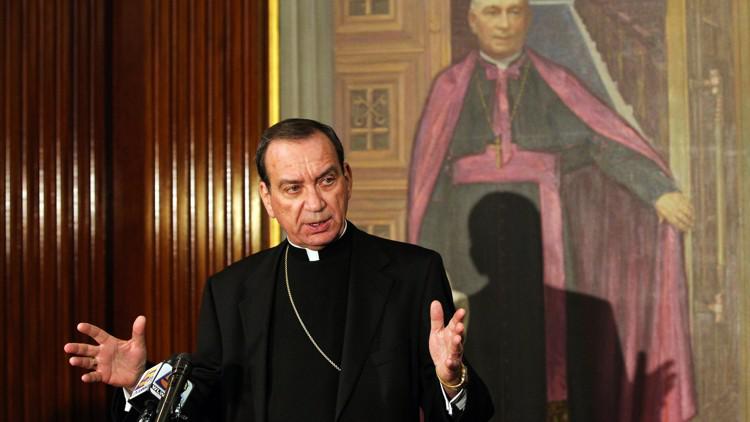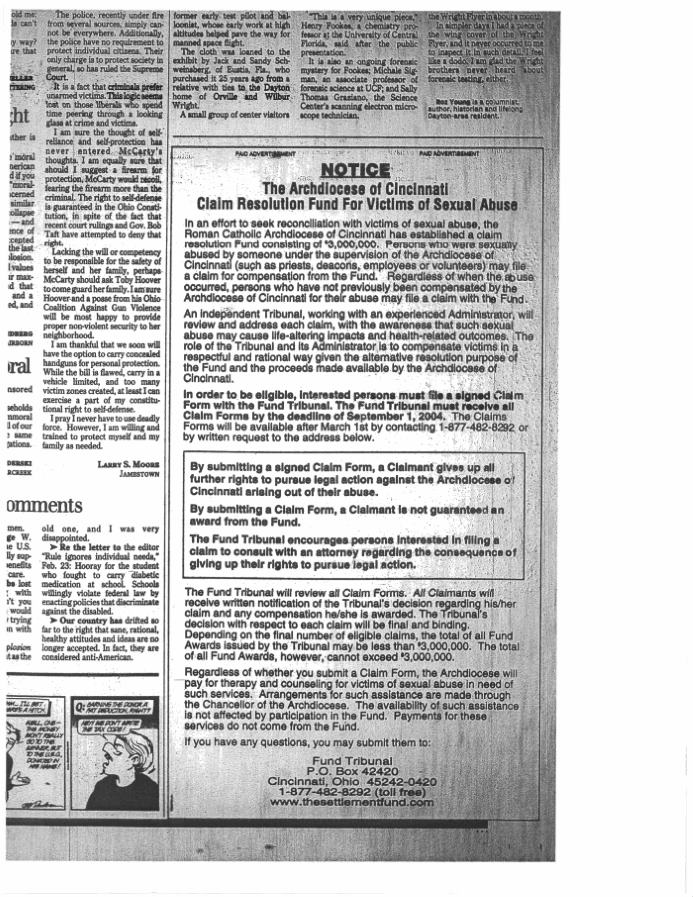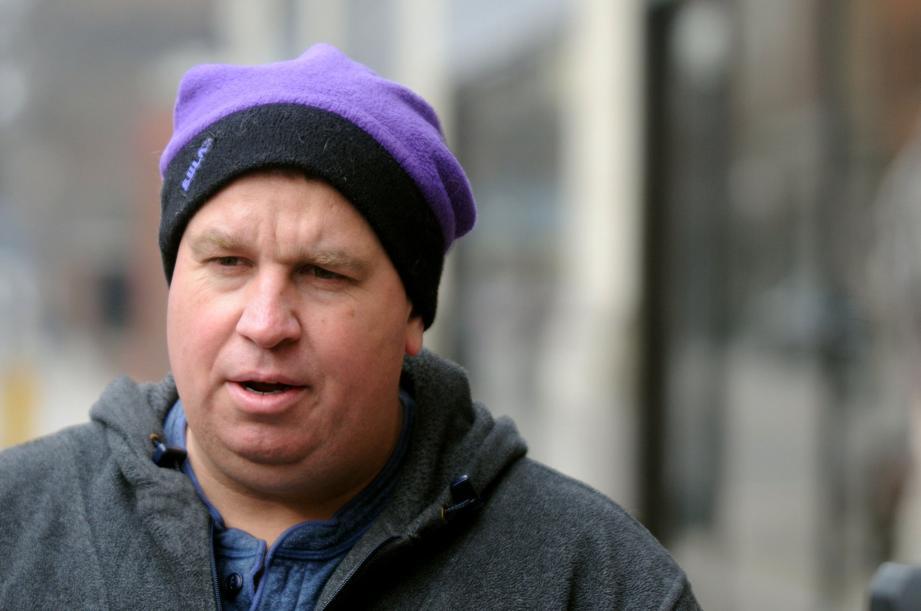|
Investigation: 15 years after settlement, Cincinnati archdiocese still receiving new abuse allegations
By Will Garbe
Nearly 15 years since the Archdiocese of Cincinnati became the first Catholic diocese in the U.S. to be criminally charged for failing to report sexual abuse of children by priests, the scandal’s emotional and financial tolls continue to compound. A Dayton Daily News analysis of archdiocesan records found the local church spent at least $17 million since 2003 on the allegations against priests and efforts to protect children. In the last two fiscal years, the church spent nearly a half-million dollars on the allegations — including life-long counseling for around 20 victims — and child protection expenses, the records show. Since 1950, the cost is nearly $20 million. Far more difficult to calculate are the scars carried by the victims. Some said they are cautiously pleased with the direction of the local 19-county archdiocese, which includes Dayton, Springfield, Hamilton and Middletown. Other survivors remain deeply critical of church leadership and skeptical the institution can protect children. Last month, an explosive grand jury report detailing the abuse of more than 1,000 other child victims by more than 300 vowed religious in Pennsylvania over the last century refocused attention on the international clergy abuse scandal, squeezing Pope Francis, the U.S. bishops and the Vatican with questions over who knew what, when. “This report … shocks, saddens, and angers Catholics everywhere, including myself,” said Archbishop Dennis Schnurr in an open letter. “The depth of depravity and evil described in these reports is stunning. No words can diminish the level of revulsion one feels at reading them. “From the depths of my heart, I am sorry for the terrible pain and suffering experienced by the victims of abuse throughout their lives. I am sorry for the deep shame that Catholic lay people rightfully feel at the inexcusable behavior of certain cardinals, bishops, and priests, the emotional exhaustion of having to defend their faith to friends and co-workers, and the discouragement of having to relive a deep tragedy that we all hoped was behind us,” the archbishop wrote. For some survivors, the personal pain of the abuse has never been behind them. “I’ve got to learn how to forgive, but I really need somebody who has been further down the road than me to walk me through this,” said Stuart Dupras, a 56-year-old Dayton man who said he was abused at age 17 by a priest in New York. “That’s the biggest problem. There isn’t really something around here for men who go through to talk about this.” A painful journeyFor years, the Archdiocese of Cincinnati has dealt with sex abuse allegations of its own. Early in the new millennium there were nearly 200 allegations against about 50 local priests, according to this newspaper’s archives. Many were made around the time of the Boston Globe Spotlight Team investigation published in 2002. “When everything happened in Boston, it started seeping across the country, and Cincinnati was one of the cities where people started telling their stories,” said Dan Frondorf, 52. “I just couldn’t believe I wasn’t the only one who had this experience.” Many of the known allegations have been settled or litigated since 2003, when then-Archbishop Daniel Pilarczyk established a review board and $3 million compensation fund as part of a plea bargain with the Hamilton County prosecutor’s office. The agreement involved Pilarczyk pleading no contest on behalf of the archdiocese as an entity to five fourth-degree misdemeanor counts of failing to report felony sex crimes against children. No individuals were charged. To take part in the fund, victims agreed to forfeit their right to sue the archdiocese. About 120 did, receiving payouts based on a variety of factors, according to news reports at the time. The payouts, at around $27,000, were among the smallest per-victim awards of any similar settlement involving 25 or more cases in the U.S., according to bishop-accountability.org, a website that tracks the data. Others fought for compensation from the church in court. The effort was largely unsuccessful, said Konrad Kircher, a Mason attorney who represented about 90 clients in litigation. In 2006, the Ohio Supreme Court ruled that such suits must be filed before the victim turns 20. “I felt better losing the case than I ever would taking their money,” said Frondorf, who accused then-Father Lawrence Strittmatter of abusing him as a 17-year-old Elder High School student. The ex-priest is among 10 former archdiocesan priests “permanently removed from the clerical state,” meaning they cannot function as a priest anywhere. Strittmatter, a former St. Albert the Great Parish priest who voluntarily requested Pope Benedict XVI remove him from priesthood in 2006, declined to comment when reached last week by phone at his Beavercreek residence. Today, Frondorf leads the Cincinnati/Dayton branch of the Survivors Network of those Abused by Priests, or SNAP. Admittedly, his work has slowed since the early 2000s. Occasionally, though, the phone starts ringing again. “With what happened in Pennsylvania in the last few weeks, we did get some phone calls in Cincinnati about how to research perpetrators,” he said, declining to elaborate because of the sensitivity of the cases. “I like to think there’s not a big demand for our services anymore.” Frondorf, though, warned the full scope of the abuse is still unknown. “I think there are a number of survivors in the Cincinnati area who have never told their story … We’re sure, just based on the sheer number of priests in the archdiocese, there are some victims who never came forward,” he said. This week, archdiocese spokesman said there are no active cases of clerical abuse of minors anywhere in the archdiocese. But the number of allegations grows each year, archdiocesan records show. In fiscal year 2017, new allegations of sexual abuse of a minor were made against three unnamed priests, all of whom are dead and two of whom were previously accused. In fiscal year 2018, which ended in June, allegations were made against seven priests, all of whom are dead. A spokesman could not immediately say if any of the priests were previously accused. “Everything that comes into the archdiocese is immediately referred to the appropriate civil authority,” said Mike Schafer, an archdiocese spokesman. The archdiocese makes the names of credibly accused, living priests known. But the archdiocese said it does not release the names of newly accused, deceased priests. “The man has no ability to defend himself, and he’s obviously not a danger to any new people, so we do not publicize that case,” Schafer said. “We’re not going to go trash the person’s reputation in the community with something that can’t be proven.” In cases the church determines credible, the archdiocese offers life-long counseling to victims, Schafer said. “We’re going to have these expenses for a good number of years, even if another priest is never accused,” he said. A more safe church?Views differ over whether today’s archdiocese does enough to protect children and vulnerable adults from abuse. The archdiocese encourages anyone with knowledge of abuse to report it and mandates background checks on all clerics, employees and volunteers, plus ongoing training for those persons. “The Archdiocese of Cincinnati is unequivocally committed to the protection of all people, children and adults, involved with any of our various ministries,” Schnurr wrote in his letter. The newspaper’s analysis found that since 2004, the archdiocese has spent more than $5.6 million on background checks and child protection training. The church said this money and other money spent on abuse has come from “general untargeted revenues available, not from the parish weekly collection basket” and other collections. Frondorf said he credits the church for these actions. “I’m hoping the fact that we’ve seen very few new cases of clergy sex abuse in the Archdiocese of Cincinnati is indicative of whatever deterrent factors they’ve taken action on,” he said. “Generally, I’m pleased and optimistic. But we’re ever vigilant of course.” Separately, Dupras and Kircher called the actions “window dressing” that does not address ongoing problems. “The problem is not with these volunteers who are being finger printed,” Kircher said. “The problem was inherent in the culture of the church. This has been going on for hundreds of years. … The Catholic Church has not instituted prevention because it would undermine their culture. The priest is Christ’s representative on earth, and the church doesn’t want to acknowledge priests have sexual urges.” In his letter, Schnurr said, “Every applicant to the seminary undergoes a full battery of psychological testing prior to acceptance into the seminary program. Once accepted, the candidate has, at a minimum, four years of formation in which he is taught what he needs to know in order to be a priest. During this time, his disposition, behavior, self-awareness, and stability and goodness of character are also evaluated.” All roads lead to RomeIn the past 15 years, during three different papacies, both survivors of abuse and archdiocese leaders have pointed fingers at the Vatican bureaucracy. Many survivors allege the Vatican ignored the abuse and engaged in an extensive cover-up effort to keep it hidden. The archdiocese has complained the Vatican moved too slow to defrock priests. “We want them all to be gone. We’re very frustrated,” former archdiocese spokesman Dan Andriacco said in 2007, when asked about disgraced priests who at the the time were still on the archdiocese payroll. “We believe that action in these cases is part of the healing process. We’d be farther along that path if these cases had been handled faster.” Victims and their advocates have long said the Vatican has worked to keep abuse under wraps. “That’s where it starts and stops,” attorney Kircher said when asked last week about the Vatican’s role in the Cincinnati sex abuse scandal. “The Vatican has had institutional knowledge for hundreds of years that this was an issue in the Catholic Church. They’ve never warned the public.” The archdiocese has long denied a cover up. In a 2003 court filing, Kircher argued the archdiocese, under instruction by the Vatican, concealed abuse “and impressed upon the victims and/or their parents the necessity of confidentiality and secrecy.” “… the Vatican in 1962 published written instructions to all diocese and bishops throughout the world to conceal incidents of sexual abuse by priests, and to swear the victims to secrecy as well,” Kircher wrote. Similar allegations have resurfaced in the Pennsylvania grand jury report released last month. “That cover-up went all the way to the Vatican,” said Pennsylvania Attorney General Josh Shapiro in a CNN interview. “The church’s own documents, that were in the secret archives, presented in the grand jury report, show the connection between the abuse and cover-up in Pennsylvania and the fact that the Vatican was informed of it.” But going after the Vatican presents major challenges. In addition to leading the world’s largest Christian faith, Pope Francis is one of the world’s last absolute monarchs, reigning over the Vatican City and the Holy See. The U.S. State Department recognizes the Holy See, as the supreme government of the Catholic Church, as a sovereign entity under international law. Dupras believes the U.S. should take on the Vatican in the way it would a hostile foreign power. “We’ve gone after North Korea for their abuses. We’ve gone after China,” Dupras said. “Why not go after the Vatican for their abuses? They were essentially running a child sex ring.” Contact: will.garbe@coxinc.com
|
.
Any original material on these pages is copyright © BishopAccountability.org 2004. Reproduce freely with attribution.



